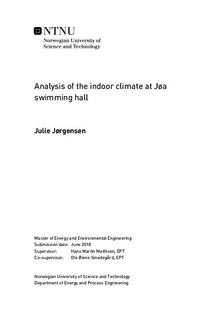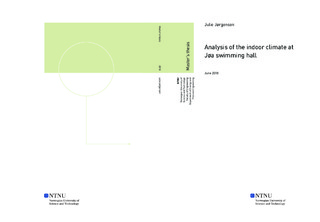| dc.description.abstract | Indoor swimming pools are popular leisure and sports facilities all over the world. Compared to normal buildings, indoor swimming pools have several challenges regarding ventilation, heating and dehumidification. In order to maintain thermal comfort, the air temperature has to be high. In addition, the indoor air quality is influenced by the water treatment system. To keep the energy consumption on an acceptable level, recirculation of air is necessary for indoor swimming pools. Jøa swimming pool in Fosnes kommune was opened in Januar 2017, and is part of a multi-purpose sports hall and serves as a therapeutic pool for the citizens of Jøa. The ventilation system is innovative and advanced and based on the principle of reversed displacement ventilation. The system has a renewable energy supply system, in addition to an innovative airflow distribution.
The objective of this master thesis was to analyse the actual performance of the ventilation system in the swimming pool in accordance with the expected performance. The analysis have been carried out in regard to indoor climate and thermal comfort.
Fieldwork was conducted at the swimming pool at Jøa. Tracer gas experiments to calculate the air change efficiency, in addition to temperature- and velocity measurements were carried out. Three different experiments were conducted, with different operations of the ventilation system. One with a manipulation of the ventilation system to supply a minimum of one air changes per hour with fresh air, a second with normal operations. The third experiment was conducted with a minimum of one air changes per hour with fresh air and with a reduction of the height of the exhaust grille. The height of the exhaust grille was reduced because of an assumption of short-circuiting of air. One smoke experiment was also carried out to get an understanding of the air flow pattern. In addition, a questionnaire was issued to the swimmers and the operators of the swimming pool.
During the field trip to Jøa it was detected that the fresh air supply was controlled by the humidity level measured in the exhaust air, whereby the air flow was not constant. A non-constant air flow and recirculation of air made the results from the tracer gas experiment less reliable. However, the logarithmic presentation of the tracer gas concentration could be utilized to get an understanding of the air change efficiency. The results showed trends to a fully mixed flow in all of the three experiments. The first experiment showed tendencies to short-circuiting of air, while for the third experiment it seemed like there was no short-circuiting of air. The smoke visualization also showed a fully mixed flow. The questionnaire showed that the majority of the people were satisfied with the indoor climate, but that they all perceived the thermal environment differently.
The current ventilation system differs a lot from how it was designed. The supply diffusers below the windows were supposed to work as "security-diffusers", but they are in constant operation. The system is designed on the principle of reversed displacement ventilation, but from the conducted measurements, it looks like the air is fully mixed. However, this does not mean a poor ventilation system. The users' seem to be satisfied with the indoor climate, but due to very few respondents, it is not possible to draw any conclusions about the indoor climate based on the questionnaire. | |

